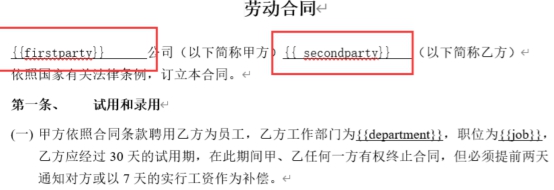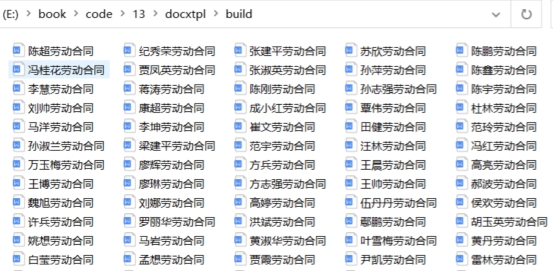在企业招聘中,最重要的事情,就是需要签订劳动合同,但是有些大的公司,因为人员过于,在设置编辑合同的时候,比较耗时耗力,编程存在的意义,就是帮助我们实现办公自动化,因此能实现自动生成合同,还是非常重要的,下面小编就来采用函数以及面向对象过程,教大家实现生成合同过程。
1、模板文件
甲方公司、乙方人员姓名、乙方部门、乙方职位、甲方人员姓名、乙方人员姓名、时间(年月日),如图所示。

2、实现代码
|
1
2
3
4
5
6
7
8
9
10
11
12
13
14
15
16
17
18
19
20
21
22
23
24
25
26
27
28
29
30
31
32
33
34
35
36
37
38
39
40
41
42
43
|
from docxtpl import docxtemplateimport osimport pymysqlimport timecur_path = os.path.dirname(__file__)tempfilename = os.path.join(cur_path, 'template', '劳动合同模板.docx')today = time.strftime("%y-%m-%d", time.localtime())def query():try:# 数据库连接,返回数据库连接对象conn = pymysql.connect(host='localhost', user='root',passwd='123456', db='test', port=3306)cur = conn.cursor()sql = 'select * from t_person_info'cur.execute(sql)result = cur.fetchall()return resultexcept exception as e:print(e)finally:conn.close()def build_hetong():result = query()for x in result:tpl = docxtemplate(tempfilename)context = {'firstparty': '灯塔教育','secondparty': x[1],'department': x[15],'job': x[16],'owner': '龙卷风','name': x[1],'sj': today}tpl.render(context)savefilename=os.path.join(cur_path,'build',x[1]+'劳动合同.docx')tpl.save(savefilename)if __name__ == "__main__":start = time.time()build_hetong()end = time.time()sj = end-startprint(f"花费时间(秒):{sj}") |
3、输出结果

实例扩展(批量word合同生成)
导入数据库
|
1
2
3
4
5
6
7
8
9
10
|
#导入对应数据库import numpy as np import pandas as pd import os import docxfrom docx.shared import ptfrom docx.oxml.ns import qn#修改项目文件地址os.chdir(r'c:\users\win7\desktop\分期账单自动化')os.getcwd() |
全部代码:
|
1
2
3
4
5
6
7
8
9
10
11
12
13
14
15
16
17
18
19
20
21
22
23
24
25
26
27
28
29
30
31
32
33
34
35
36
37
38
39
40
41
42
43
44
45
46
47
48
49
50
51
52
53
54
55
56
57
58
59
60
61
62
63
64
65
66
67
68
69
70
71
72
73
74
75
76
77
78
79
80
81
82
83
84
85
86
87
88
89
90
91
92
93
94
95
96
97
98
99
100
101
102
103
104
105
106
107
108
109
110
111
112
113
114
115
116
117
118
119
|
'''人民币数字转大写汉字'''# coding: utf-8import warningsfrom decimal import decimaldef cncurrency(value, capital=true, prefix=false, classical=none): ''' 参数: capital: true 大写汉字金额 false 一般汉字金额 classical: true 元 false 圆 prefix: true 以'人民币'开头 false, 无开头 ''' if not isinstance(value, (decimal, str, int)): msg = ''' 由于浮点数精度问题,请考虑使用字符串,或者 decimal.decimal 类。 因使用浮点数造成误差而带来的可能风险和损失作者概不负责。 ''' warnings.warn(msg, userwarning) # 默认大写金额用圆,一般汉字金额用元 if classical is none: classical = true if capital else false # 汉字金额前缀 if prefix is true: prefix = '人民币' else: prefix = '' # 汉字金额字符定义 dunit = ('角', '分') if capital: num = ('零', '壹', '贰', '叁', '肆', '伍', '陆', '柒', '捌', '玖') iunit = [none, '拾', '佰', '仟', '万', '拾', '佰', '仟','亿', '拾', '佰', '仟', '万', '拾', '佰', '仟'] else: num = ('〇', '一', '二', '三', '四', '五', '六', '七', '八', '九') iunit = [none, '十', '百', '千', '万', '十', '百', '千','亿', '十', '百', '千', '万', '十', '百', '千'] if classical: iunit[0] = '元' if classical else '圆' # 转换为decimal,并截断多余小数 if not isinstance(value, decimal): value = decimal(value).quantize(decimal('0.01')) # 处理负数 if value < 0: prefix += '负' # 输出前缀,加负 value = - value # 取正数部分,无须过多考虑正负数舍入 # assert - value + value == 0 # 转化为字符串 s = str(value) if len(s) > 19: raise valueerror('金额太大了,不知道该怎么表达。') istr, dstr = s.split('.') # 小数部分和整数部分分别处理 istr = istr[::-1] # 翻转整数部分字符串 so = [] # 用于记录转换结果 # 零 if value == 0: return prefix + num[0] + iunit[0] haszero = false # 用于标记零的使用 if dstr == '00': haszero = true # 如果无小数部分,则标记加过零,避免出现“圆零整” # 处理小数部分 # 分 if dstr[1] != '0': so.append(dunit[1]) so.append(num[int(dstr[1])]) else: so.append('整') # 无分,则加“整” # 角 if dstr[0] != '0': so.append(dunit[0]) so.append(num[int(dstr[0])]) elif dstr[1] != '0': so.append(num[0]) # 无角有分,添加“零” haszero = true # 标记加过零了 # 无整数部分 if istr == '0': if haszero: # 既然无整数部分,那么去掉角位置上的零 so.pop() so.append(prefix) # 加前缀 so.reverse() # 翻转 return ''.join(so) # 处理整数部分 for i, n in enumerate(istr): n = int(n) if i % 4 == 0: # 在圆、万、亿等位上,即使是零,也必须有单位 if i == 8 and so[-1] == iunit[4]: # 亿和万之间全部为零的情况 so.pop() # 去掉万 so.append(iunit[i]) if n == 0: # 处理这些位上为零的情况 if not haszero: # 如果以前没有加过零 so.insert(-1, num[0]) # 则在单位后面加零 haszero = true # 标记加过零了 else: # 处理不为零的情况 so.append(num[n]) haszero = false # 重新开始标记加零的情况 else: # 在其他位置上 if n != 0: # 不为零的情况 so.append(iunit[i]) so.append(num[n]) haszero = false # 重新开始标记加零的情况 else: # 处理为零的情况 if not haszero: # 如果以前没有加过零 so.append(num[0]) haszero = true # 最终结果 so.append(prefix) so.reverse() return ''.join(so) |
到此这篇关于python生成word合同的实例方法的文章就介绍到这了,更多相关如何使用python生成word合同内容请搜索服务器之家以前的文章或继续浏览下面的相关文章希望大家以后多多支持服务器之家!
原文链接:https://www.py.cn/jishu/jichu/22843.html










